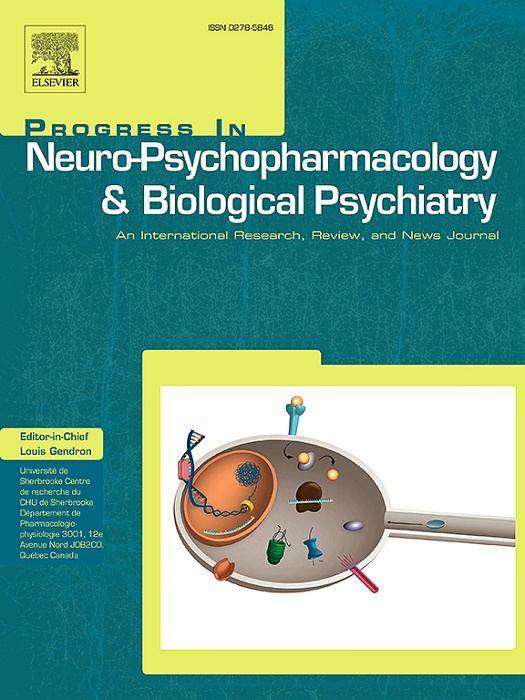Altered hemispheric lateralization of cortico-basal ganglia-thalamic network associated with gene expression and neurotransmitter profiles as potential biomarkers for panic disorder
IF 3.9
2区 医学
Q1 CLINICAL NEUROLOGY
Progress in Neuro-Psychopharmacology & Biological Psychiatry
Pub Date : 2025-07-13
DOI:10.1016/j.pnpbp.2025.111441
引用次数: 0
Abstract
Functional brain lateralization, a key feature of the human brain that shows alterations in various mental disorders, remains poorly understood in panic disorder (PD), and its investigation may provide valuable insights into the neurobiological underpinnings of psychiatric conditions. This study investigates hemispheric lateralization in drug-naive patients with PD before and after treatment, explores its associations with gene expression and neurotransmitter profiles, and examines its utility for diagnosis and treatment outcome prediction. Fifty-eight patients and 85 healthy controls (HCs) were enrolled. Clinical assessments and resting-state functional magnetic resonance imaging scans were conducted before and after a 4-week paroxetine monotherapy. Intra-hemispheric functional connectivity strength (FCS), inter-hemispheric FCS, and parameter of asymmetry (PAS) were calculated. Imaging-transcriptomic and imaging-neurotransmitter correlation analyses were conducted. PAS was used in machine learning models for classification and treatment outcome prediction. Compared with HCs, patients exhibited enhanced intra-hemispheric FCS and decreased PAS in the caudate nucleus/pallidum and thalamus, with associated genes, dopamine and serotonin receptor densities, and vesicular acetylcholine transporter densities linking these lateralization alterations to neural signaling and synaptic function. FCS and PAS results were consistent across different correlation thresholds (0.15, 0.2, and 0.25). No significant changes in FCS or PAS were observed following treatment. PAS demonstrated excellent performance in classification (accuracy = 75.52 %) and treatment outcomes prediction (r = 0.763). Hemispheric lateralization in the cortico-basal ganglia-thalamic network was significantly altered in patients with PD, with these changes linked to disruptions in genes and neurotransmitter profiles which are associated with neural signal transduction and synaptic function. PAS shows promise as a biomarker for PD diagnosis and treatment outcome prediction.
与基因表达和神经递质谱相关的皮质-基底神经节-丘脑网络半球侧化改变作为惊恐障碍的潜在生物标志物
功能性脑侧化是人类大脑的一个关键特征,显示出各种精神疾病的变化,但在恐慌症(PD)中仍然知之甚少,其研究可能为精神疾病的神经生物学基础提供有价值的见解。本研究调查了PD患者治疗前后的半球偏侧,探讨了其与基因表达和神经递质谱的关系,并检验了其在诊断和治疗结果预测中的应用。纳入了58名患者和85名健康对照(hc)。在帕罗西汀单药治疗4周前后进行临床评估和静息状态功能磁共振成像扫描。计算半球内功能连接强度(FCS)、半球间功能连接强度(FCS)和不对称参数(PAS)。成像-转录组学和成像-神经递质相关性分析。PAS在机器学习模型中用于分类和治疗结果预测。与hc相比,患者表现出半球内FCS增强,尾状核/白质和丘脑PAS减少,相关基因、多巴胺和5 -羟色胺受体密度以及囊泡乙酰胆碱转运体密度将这些侧化改变与神经信号和突触功能联系起来。FCS和PAS结果在不同的相关阈值(0.15、0.2和0.25)上是一致的。治疗后FCS或PAS未见明显变化。PAS在分类(准确率为75.52%)和治疗结果预测(r = 0.763)方面表现优异。PD患者皮质-基底神经节-丘脑网络的半球偏侧性显著改变,这些变化与基因和神经递质谱的破坏有关,这些基因和神经递质谱与神经信号转导和突触功能相关。PAS有望成为帕金森病诊断和治疗结果预测的生物标志物。
本文章由计算机程序翻译,如有差异,请以英文原文为准。
求助全文
约1分钟内获得全文
求助全文
来源期刊
CiteScore
12.00
自引率
1.80%
发文量
153
审稿时长
56 days
期刊介绍:
Progress in Neuro-Psychopharmacology & Biological Psychiatry is an international and multidisciplinary journal which aims to ensure the rapid publication of authoritative reviews and research papers dealing with experimental and clinical aspects of neuro-psychopharmacology and biological psychiatry. Issues of the journal are regularly devoted wholly in or in part to a topical subject.
Progress in Neuro-Psychopharmacology & Biological Psychiatry does not publish work on the actions of biological extracts unless the pharmacological active molecular substrate and/or specific receptor binding properties of the extract compounds are elucidated.

 求助内容:
求助内容: 应助结果提醒方式:
应助结果提醒方式:


